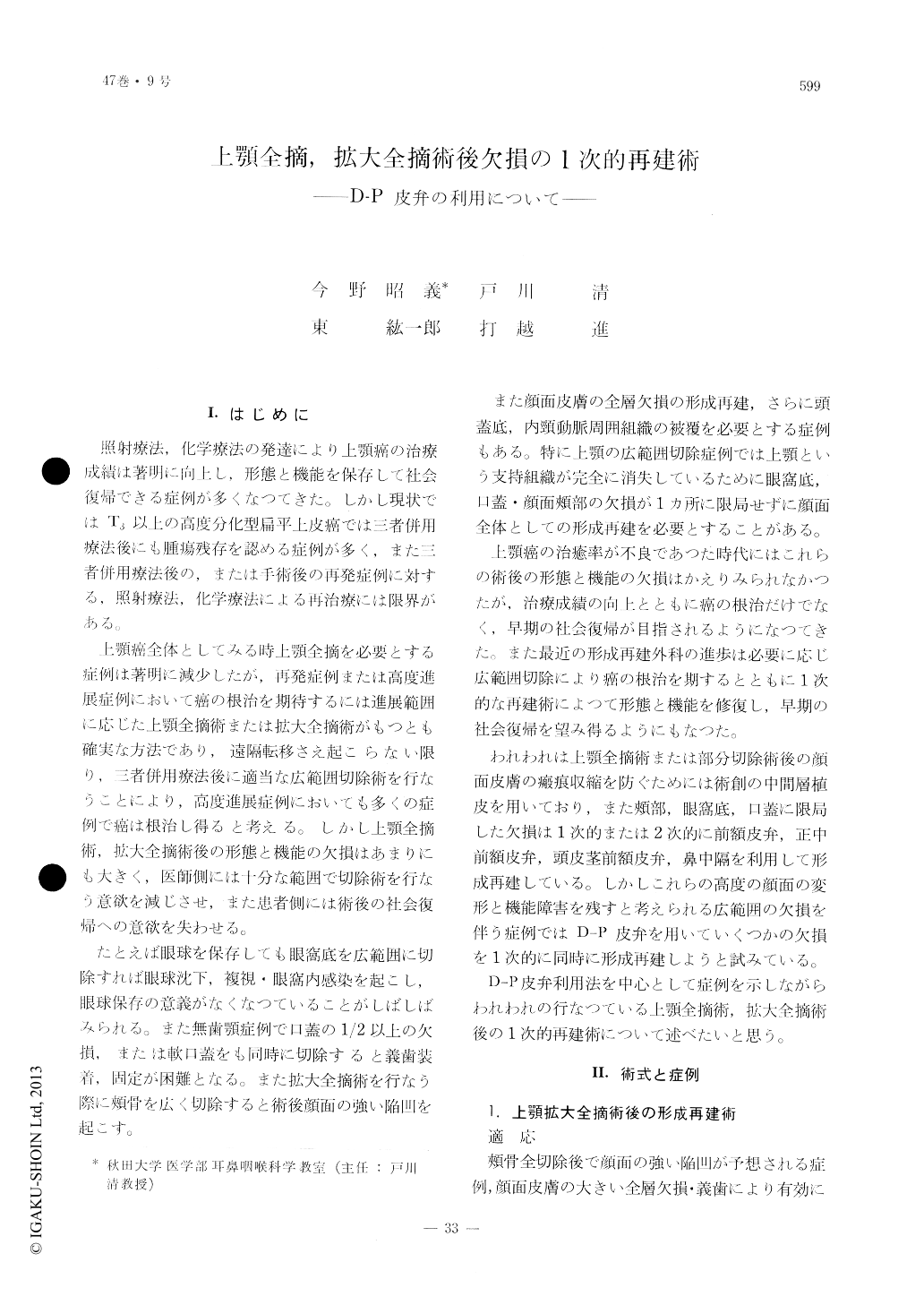Japanese
English
- 有料閲覧
- Abstract 文献概要
- 1ページ目 Look Inside
I.はじめに
照射療法,化学療法の発達により上顎癌の治療成績は著明に向上し,形態と機能を保存して社会復帰できる症例が多くなつてきた。しかし現状ではT3以上の高度分化型扁平上皮癌では三者併用療法後にも腫瘍残存を認める症例が多く,また三者併用療法後の,または手術後の再発症例に対する,照射療法,化学療法による再治療には限界がある。
上顎癌全体としてみる時上顎全摘を必要とする症例は著明に減少したが,再発症例または高度進展症例において癌の根治を期待するには進展範囲に応じた上顎全摘術または拡大全摘術がもつとも確実な方法であり,遠隔転移さえ起こらない限り,三者併用療法後に適当な広範囲切除術を行なうことにより,高度進展症例においても多くの症例で癌は根治し得ると考える。しかし上顎全摘術,拡大全摘術後の形態と機能の欠損はあまりにも大きく,医師側には十分な範囲で切除術を行なう意欲を減じさせ,また患者側には術後の社会復帰への意欲を失わせる。
Recent advances in chemotherapy and radio-therapy have brought about a marked improve-ment on the cure rate of maxillary carcinomas. However, in advanced cases of well differenciat-ed epidermoid carcinomas as in instages T3 or T4 radical surgery such as total or extended total maxillectomy is still needed. The conven-tional radical surgery upon these advanced cases invariably result in miserable facial deformity and functional disturbances, the factors which often prevent the surgeons from removing the tumor with ample surrounding tissues. Moreover, if primary reconstruction of the defect is perfo-rmed simultaneously at the time of the complete removal of the lesion, there would be not only improvement of cure rate but, also, of preventing the development of postoperative deformities and functional losses.
Primary reconstruction using D-P flap should be considered when there is a possibility of postoperative occurrence of any combination of defects as in the following category :
1. Marked retraction and flattening of the face, particularly in its lateral aspect which are often seen after extended total maxillectomy combined with total resection of the zygoma.
2. Large defect of the soft and hard palate which cannot be effectively closed by any pro-sthesis.
3. Full-thickness large defect of facial soft tissues after extended resection of the subcutane-ous soft tissues of the face which may cause marked cicatricial contractions and fistular for-mations.
4. The external ocular muscles and other con-tents in the orbita exposed by resection of the orbital bone, fascia and fat.
The raw surface of the wound, particularly that of the lateral and anterior is covered with D-P flap. The palatal defect is reconstructed by a second stage operation using a pedicle the flap.
In cases where a large defect of the facial skin occur the wound is covered by the tip of the D-P flap folded outward on itself, forming a double layer flap,or by combination of the sca-lping flap and the D-P flap.
In cases where an extended total maxillectomy is performed with preservation of the eye-ball and the external ocular muscles, the orbital con-tents are covered and suspended with a sheet of the fascia lata, and then covered again with the D-P flap.
To prevent flap necrosis for some time after the primary operation, a large bite-block is plac-ed between the gingivas, the remaining upper and lower, which is also indispensable for preve-nting the occurrence of trismus by cicatricial contraction of the masseter muscles after ex-tended total maxillectomy.
During the operation a repeated frozen section examination of the removed tissues is highly neceessary to ascertain that there is no residual tumor tis sues left behind. Postoperative through histopathological examination of the excised tissues is, also, essential.
Through these means the postoperative cos-metic and functional effects have been quite satisfactory.

Copyright © 1975, Igaku-Shoin Ltd. All rights reserved.


